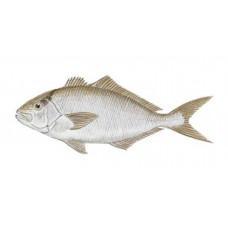Latin name
Seriola fasciata
Other names
Amberjack, jack; French: sériole babianc; Spanish: medregal listado.
Identification
The amberjack has an olive-green or brownish back above the lateral line and silvery below it. A dark olive-brown diagonal stripe extends from the mouth through both eyes to the first dorsal fin. It is very similar in appearance to the large amberjack, but has a deeper body profile, proportionally large eyes, and eight spines on the first dorsal fin.
Distribution
The Lesser Amberjack lives in the western Atlantic Ocean from Massachusetts to Brazil.
Habitat
The Lesser Amberjack lives deeper than others, usually 180 to 410 feet deep, and spawns in offshore waters.
Size
Reports on the size of this species vary widely, from 12 inches long to less than 10 pounds.
Life history and Behavior
No information
Food and feeding habits
The Lesser Amberjack is a bentopelagic, predatory species, with adults feeding on smaller fish and cephalopod mollusks.
Reproduction
No information
| Classification | |
| Phylum | Chordata |
| Class | Actinopterygii |
| Family | Carangidae |
| Genus | Seriola |
| Species | S. fasciata |
| Features | |
| Conservation status | Least Concern |
| Habitat | Pelagic |
| Life span, years | 17 |
| Maximum body weight, kg | 5 |
| Maximum length, cm | No information |
| Sailing speed, m/s | No information |
| Threat to people | Edible |
| Way of eating | Predator |


